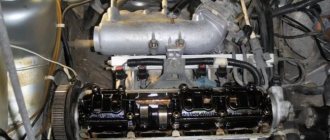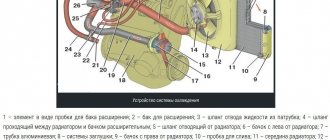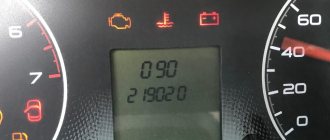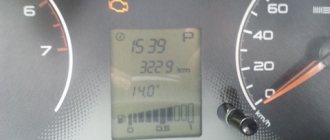Engine operating temperature on a Lada Granta car should be 90 degrees, but most owners complain that the temperature does not rise above 80 degrees. Even despite the above-zero temperature outside.
Apparently AvtoVAZ decided to further protect itself by installing a thermostat that opens already at 85°. The most interesting thing is that AvtoVAZ defines the tolerances for the opening temperature of the thermostat as: (85±8.3) ºС, i.e. from 77 to 93 ºС
. This is a scatter, isn't it?
The operating temperature of the engine must be at least 90ºС.
To learn how to find out the engine temperature when your car is not equipped with a temperature indicator on the instrument panel, read the material: how to check the engine temperature.
Motor temperature
It turns out that the temperature regime in which internal combustion engines operate depends very little on the ambient temperature. To a greater extent, this indicator is influenced by the design, as well as the operating features of a particular unit.
From a design point of view, motors are distinguished by the cooling method, design, type of fluids used, materials, compression, presence of supercharging, operating speed, and level of wear. So, in each individual case the operating temperature of the engine is different. There are also quite a lot of factors that influence the regime.
High temperatures are very harmful to any motor, regardless of its design. Therefore, you need to maintain the correct temperature regime.
Maintenance
In accordance with the manufacturer's regulations, engine 11186 must be serviced in the following order:
Timing belt3/50Battery1/20Valve clearances2/20Crankcase ventilation2/20Belts driving attachments2/20Fuel line and tank cap2/40Motor oil1/10Filter (oil)1/10Filter (air)1 – 2/40Filter (fuel)4/40Fittings and hoses heating/cooling 2/40 Coolant 2/40 Oxygen sensor 100 Spark plugs 1 – 2/20 Exhaust manifold 1This is exactly the frequency of maintenance that the ICE 11186 device is designed for.
The role of cooling in creating a favorable temperature regime
The operating temperature of the engine depends on the efficiency of the cooling system. It is a complex of all devices that supply coolant to technological areas and then remove heat to the atmosphere.
The purpose of the coolant is to provide the most favorable conditions for the functioning of engines. And also so that when working in any conditions, the temperature regime is maintained at the same level. When the fuel burns, the temperature at this moment is about 2000 degrees. And the cooling system allows you to reduce it to 90 degrees. This is considered the optimal temperature.
Why is overheating dangerous?
If the engine gets very hot, this can ultimately lead to dire consequences for the car owner. Overheating leads to increased wear of parts and components.
If the motor has been running for a short time at high temperatures, then there is nothing to be afraid of. Nothing will happen to him in 5 minutes. The reasons for this are various malfunctions with the fan or incorrect operation of the thermostat. If you stop the car in time, the maximum consequences are melting of the pistons. For a new car, short-term overheating is not at all scary.
If the engine operating temperature exceeds the norm for about 20 minutes or more, then there is a serious risk of cylinder head deformation and gasket burnout. Inter-ring partitions may also become unusable.
If the engine is completely overheated, this is a real disaster. This leads to damage to every part, every unit. The motor could even explode if the components were a little more reliable. If there is severe overheating, the piston group will certainly melt, and liquid metal will fall on the cylinders. This will make the piston stroke much harder, which means more wear. Also, engine diagnostics after overheating often reveals inevitable problems in the operation of the lubrication system. Overheated oil will not have its original properties, and rubbing vapors will destroy themselves. Pistons can puncture the cylinder head, and the crankshaft often breaks in two.
Design Features
By default, the 11186 engine retains all the design features of the original 21114, from which it originated:
- volume 1.6 l;
- the block height is 2.3 mm greater than that of 2110;
- crankshaft with an increased crank radius by the same 2.3 mm (piston stroke 75.6 mm, respectively);
- ShPG, flywheel and crown from 2110.
In addition, a feature for the 11186 engine is the bending of the valves on the pistons when the timing belt drive breaks:
- the piston skirt is reduced here to make it lighter;
- It is physically impossible to make a deep hole for the valve inside the piston.
The manufacturer's manual contains a description of the components and parameters of the internal combustion engine, which are most often compared with the characteristics of the 11183 engine, which has the most similar markings. The main differences between these power drives from the same manufacturer are:
- torque is 15 Nm more;
- power 87 l. With. instead of 82 l. With.;
- motor 11186 has been produced since 2011, and its predecessor 11183 since 2004;
- instead of serial pistons from 2110 weighing 350 g, a lightweight version 21116 weighing 240 g is used;
- connecting rod length increased from 121 mm to 133.32 mm;
- the piston skirt has a graphite coating, the metal in the area of the first ring is anodized;
- combustion chamber 30 cm3 instead of 26 cm3;
- compression ratio increased from 9.6 to 10.5;
- The cylinder head gasket is all-metal, its thickness has been reduced from 1.2 mm to 0.43 mm;
- the cylinder head is 1.2 mm higher to compensate for the enlarged combustion chamber;
- the diameter of the bolts was reduced from M12 to M10 to reduce cylinder deformations during tightening;
- the flow channels in the cylinder head have been increased in diameter, nozzles have been installed to cool the piston heads;
- the working chamfer under the valves is maintained longer due to the strengthening of the aluminum alloy using a special technology;
- since the holes in the pistons are not enough to ensure the safety of the valves, a high-strength timing belt from the Gates manufacturer is used;
- the camshaft V-belt received an automatic tensioner, which had not previously been used in VAZ engines;
- the piston system is protected externally from overheating by a cooling jacket integrated into the cylinder block;
- the length of the receiver channels has been increased, the characteristics of the internal combustion engine are close to those of a 16 valve engine;
- the catalytic collector has a flattened block, which made it possible to separate the ducts and get rid of power losses and turbulence;
- the generator is mounted on a bracket, so its drive belt is not overtightened, like 11183, and lasts longer;
- The cabin heat exchanger and expansion tank are included in the thermostat in parallel, the operating error has decreased to 2 degrees instead of 5 degrees.
Timing belt cover 11186 on the right, improved design
On the right is the catalytic collector 11186 with a rational exhaust circuit
Modified generator mounting unit
New thermostat design
According to the AvtoVAZ plant, the ICE 11186 has a potential of 120 hp. (without resource reduction) or 180 l. With. (the resource will be reduced due to intensive wear of the piston). The manufacturer recommends tuning exclusively through modifications of components and mechanisms without the use of turbines.
What causes engine overheating?
In most cases, the engine heats up in the summer. But similar cases are also observed in winter and autumn. The reasons can be very different. Overheating can be external or internal.
External overheating can be determined by the increase in temperature of the cooling mixture. The driver can notice this and react immediately. And when the engine heats up from the inside, it is difficult to notice right away. The high temperature remains inside the engine, the coolant temperature does not increase. And the unit suddenly loses power.
The first reason is the lack of cooling mixture in the system. Liquid may leak from the system due to depressurization. Engine cooling in modern cars consists of many different pipes, pipes, clamps, and gaskets. A leak can happen anywhere. Leaks can be easily diagnosed. These are white spots or streaks on the outer parts of the motor. This includes drops of liquid under the car after parking. But the leak is nonsense. It's worse when the coolant goes into the lubrication system. There is a risk of getting a water hammer or - even worse - a jammed crankshaft.
The second reason is ineffective cooling of the radiator. There are several possible problems here. If the fan is not electric, but is powered by the crankshaft, then it is worth checking the belt tension. If the airflow is electric, then problems should be looked for in the thermostat. Another culprit is the engine radiator. Dirt easily gets into its ribs and it becomes clogged. This can be diagnosed if the temperature returns to normal slightly after parking.
Malfunctions in the thermostat also lead to overheating. Various deposits accumulate in the cooling system, and this leads to deterioration in the performance of the elastic element of the thermostat. It simply no longer records the temperature of the coolant mixture. If it is installed in one position, it will pump the mixture in a large circuit or in a small one. The thermostat also really doesn’t like the effects of our hard water.
How effectively the cooling will work depends on the level of coolant flow that is pumped through the system. Its consumption depends on the crankshaft speed. But it’s summer, it’s hot, it’s a highway. There is a long and serious climb ahead and a KamAZ. It is impossible to overtake him due to oncoming traffic. The internal combustion engine is boiling. And why all? There is no speed, the air flow is weak, the speed is low, cooling has virtually no effect, and the engine operates in hard mode despite the fact that the optimal operating temperature of the VAZ engine is 90 degrees. Everything is here at once.
There are other reasons, but these are the most popular.
Information letter AvtoVAZ (excerpt)
Excerpt from the “Information letter to AvtoVAZ dealers.”
4.3 Owners of cars of the Lada Granta (2190) and Kalina FL (2192, 2194) families state a fact: the average coolant temperature on their current cars is 7–10 degrees lower than on the previous Priora, Samara and Kalina models. Due to subjective “unusuality”, this fact has been elevated by consumers and service station personnel to the rank of a discrepancy (defect) called “underheating” of the engine.
4.4 Maintaining the coolant temperature on cars of the Lada Granta (2190) and Kalina FL (2192, 2194) family in the temperature range below the “usual” ones on previous models of Priora, Samara and Kalina cars does not lead to increased fuel consumption, increased wear of engine parts and any other negative consequences. Accordingly, in the absence of negative consequences and the absence of a coolant temperature standard, “underheating” of the engine according to clause 4.3 is not a non-compliance (defect).
4.5 A consumer’s claim for non-conformity (defect) “underheating” of the engine should not be accepted by service station personnel unless it is accompanied by a consumer complaint about any additional associated negative manifestation. If an unfounded claim is rejected, the consumer must be explained the features of the engine cooling system of cars of the Lada Granta (2190) and Kalina FL (2192, 2194) family.
That's the point of the whole guarantee! Rivet the cars from the beginning with defects, and they all went through the woods! Explaining this by saying that this is a design feature of the car's cooling system.
I have the same nonsense
The temperature does not rise above 80, even in the city or on the highway. I even put cardboard in the radiator, so I understand that it’s not just me who does this?
Yes, my engine temperature on Kalina was 85 87 from the beginning. The time has come to replace the thermostat, now the temperature does not rise above 80. It seems to say everything is fine, but it seems to me that now it has started to take oil. Not because the temperature has become lower.
I heard that the temperature was lowered specifically to eliminate detonation.
I don’t have a temperature gauge, but warm air comes out of the nozzles, so I think everything is normal..
In my friend’s Priora, the temperature gauge needle is always slightly above the middle, the consumption is 8 liters, so I think that there is no problem.
I know that this is the operating temperature, but when I see 80 degrees when flipping through the onboard, I always get scared.
I have 11186 on the highway 84-86 degrees in the summer, the car is from April 2016, the mileage is 1700 km
But for me, on the contrary, it goes off scale to 102 and the ventilation kicks in
I have a Grant 2013 fan that turns on at 100 degrees
But for me, on the contrary, it goes off scale to 102 and the ventilation kicks in
temperature on the thermostat and not on the fan
The same crap 100-103 and the fan turns on. Is this normal or should I go and fidget with the dealer?
All these changes allowed the new generation cars to gain a number of advantages:
by removing more heat from the heater core, it was possible to improve the performance of the stove; it was possible to achieve more accurate engine temperature control; fuel consumption decreased and vehicle dynamics improved, this was achieved by increasing the ignition timing.
Only there are differences in the engine, for example, the valve seats are with supposedly metal ceramics mixed in, they don’t sag longer on the Datsun grenade, maybe they messed up something with the shorts, you need to ask the specialists or who knows about something!☺☺☺☺
Is everyone's check *** lit up? I answer, at 12 I took the “norm”, by the way, who managed to fit it in for how long in 12?, it’s still burning, in May it’s already 5! and s...ka x..y burned out)! Quality is his mother.
On highway 86 in the city it went up to 105.
I know how to turn the fan to 102 degrees fret grant, how to reduce it
buy an on-board computer for the Lada Granta with which you can adjust the temperature at which the electric fan turns on. The price of a computer is from 1500 and more.
Install on-board staff and increase it to at least 50☺
When I turn on the air conditioner, it goes off scale to 109, this is generally normal.
On my grant: the operating temperature is 85 (6) degrees, in a traffic jam (when you stand for a long time) it reaches 103 and the fan immediately turns on, cools down to 98 and the fan turns off.
The only disadvantage of lowering the operating temperature of the coolant within the specified limits is the operation of the stove at very low temperatures. An increase in temperature leads to the possibility of leaning the mixture. It would seem that you can save on fuel. But the detonation zone expands and the engine is forced to operate at speeds (up to approximately 3000 rpm) either with detonation, losing up to 7% of torque, or with later advance angles, losing the same percentages. The fact is that the most optimal pressure regime over the piston is when the maximum of this pressure occurs at 10-12 degrees of crankshaft rotation after TDC. The whole point of the ignition timing characteristic is based on this. The totality of the dependence of the ignition timing on the speed, when this condition is met, is called the optimal ignition timing curve, which the designer strives for. But below 3000 rpm (maybe a little less depending on engine design and tuning) this theoretical curve enters the detonation zone. Therefore, in this speed zone, any gasoline engine operates with advance angles that are late relative to the optimum. This can be seen in the pickup after 3000 rpm, where the control system brings the advance angles to the optimum. Thus, by lowering the temperature, the designer reduced the detonation zone and increased the ignition timing, slightly enriching the mixture, and came closer to the optimal performance. And this is an increase in torque in the zone up to 3000 rpm. So it turns out that by raising the temperature you lose torque and power in the working zone itself (up to 3000 rpm) when the knock sensor is triggered. And by lowering it, you get a slightly enriched mixture, but use it more fully due to more optimal angles. That is, by zeros. But personally, I prefer to keep the knock sensor triggered as little as possible. And I won’t raise my 84 degrees of fluid and I don’t recommend it. Everyone decides for themselves.
Not just overheating...
In addition to overheating, there is also hypothermia. But this does not harm the engine components as much. Often this phenomenon occurs due to low temperature outside the car. In a supercooled unit, the oil thickens and has weak lubricating properties. This is the reason for increased wear. Hypothermia also causes fuel to enter the crankcase. As fuel flows, it washes lubricant off important parts. There is increased wear of the piston and cylinder group. With all this, the engine loses its power.
Malfunctions: causes, elimination
Like all internal combustion engines with mechanical adjustment of valve clearances, the 11186 engine requires periodic adjustment of this characteristic. In addition, during operation, characteristic “diseases” of this particular version of the power drive were identified:
| Bend valves | broken timing belt | periodic wear monitoring |
| Ignition system interruptions | failure of the corresponding block | replacing the ignition module |
| Increased oil consumption | development of main liners | replacement of consumables |
| Knock | wear of pistons, bearings | replacement of parts |
When repairing piston and crankshaft engines, it is recommended to use original components from the AvtoVAZ manufacturer. Because only he uses special technologies for strengthening structural materials. From third-party companies, the metal may be “raw”; the resource of such consumables cannot be analyzed.
The ignition module cannot be repaired
If overheating occurs
When your engine suddenly overheats or your cooling system suddenly stops working, the following actions can prevent catastrophic consequences.
If you can park safely on the side of the road, park right next to the curb and turn off the engine. As soon as the engine temperature arrow has left the danger zone, and the temperature is in optimal values, you can continue driving.
To help your unit return to normal faster, it is better to open the hood. This way the heat can escape very quickly. You should do this extremely carefully - there is a risk of getting burned.
There is no need to attempt to open the radiator cap. If you open it, steam and coolant will come out of the radiator. It is under pressure - you could be seriously injured.
How to fix breakdowns
Repair of ODS elements is not considered as part of troubleshooting. In most cases, replacement of failed parts is necessary.
Replacing the thermostat
Lada Granta is available with two types of engines: one of them is 8-valve, the other is 16-valve. The location of the thermostat on these power plants is somewhat different, which means that replacement is carried out with certain differences.
To replace the thermostat on an eight-valve engine, you will need a small set of tools: socket wrenches, screwdrivers, a Torex wrench and a container for draining the coolant.
The replacement procedure is simple; to do this, you need to follow a number of steps:
- Place the car on a level surface and use a jack to raise the front end.
- After unscrewing the bolts securing the engine protection, remove it.
- Place a suitable container under the plug to drain the coolant from the radiator.
- Unscrew the cap from the expansion tank neck.
- Unscrew the drain plug and wait until the liquid drains.
- Loosen the thermostat pipe clamp from the rear and disconnect the hose.
- Loosen the clamp on the front thermostat pipe and disconnect it.
- The ground wire is secured with a nut on the thermostat stud - unscrew it and disconnect the wire.
- Unscrew both nuts that secure the thermostat to the studs and remove it.
- Remove the O-ring and, unscrewing the three nuts, remove the thermostat cover.
- Press and rotate the locking plate to remove the cover.
- Remove the spring with the valve mechanism.
Installing a new thermostat is carried out in the reverse order. If the hoses will not be changed, then to prevent possible leakage of antifreeze, it is recommended to lubricate them from the inside with a small amount of sealant before installation.
After installing the thermostat, all pipes are tightened with new clamps, and coolant is poured into the expansion tank.
Then you need to start the engine and check the operation of the cooling system, if necessary, remove the air lock. To replace the thermostat on a 16-valve engine, the same set of tools is used, steps for an 8-valve engine are repeated from 1 to 6, then the process is as follows:
- Disconnect all pipes through which coolant is supplied to the thermostat by loosening the clamps.
- Unscrew the fastening bolts and remove the thermostat cover from the seat.
- Remove the sealing ring, turn the fixing plate by pressing and remove the spring with the valve mechanism.
Installation of a new thermostat is carried out in the reverse order. All hoses are connected, antifreeze is poured into the system, the engine is started, and if necessary, the air lock is removed, after which antifreeze is added to the tank to the mark between the minimum and maximum. There are many fakes and low-quality parts on the car parts market, so it is advisable to check the thermostat before installation. To do this, you need to heat water in a container to a temperature close to boiling and place a thermostat there; if the valve begins to open slightly, it means the device is working.
Replacing the thermostat can be done with your own hands in a regular garage. There are no difficulties, but you will have to spend money on a new part, pipes, if changed, and coolant. To save time, you can contact any car service center, where within 20-30 minutes the technicians will change the thermostat for 200-300 rubles.
Replacing the coolant pump
To replace the pump on a Grant you will need a set of sockets, wrenches and screwdrivers. Many car owners combine pump replacement with timing belt replacement. At the initial stage, the process is identical for both procedures:
- Disconnect the negative terminal from the battery.
- Using a 17 mm wrench, rotate the camshaft pulley by the fastening nut until the mark on the pulley matches the mark on the rear casing cover. So the piston in the first cylinder will be at top dead center.
- The nut securing the timing belt tensioner roller is unscrewed and the tension is weakened.
- Drain the coolant through the drain hole on the radiator.
- Unscrew the bolts securing the pump to the cylinder block and remove it together with the sealing gasket.
- The new pump must be installed with the number facing up, and it is recommended to replace the sealing gasket.
Next, installation of the belt and pulleys (if the timing belt has been changed) is carried out in the reverse order. In this case, you need to ensure that the marks are not knocked down, otherwise the valve timing will be disrupted.
A car service center will charge from 800 to 1,500 rubles for such work, depending on the type of engine (8 or 16 valves).
How to repair an expansion tank
During engine operation, the expansion tank is constantly deformed from increasing and decreasing pressure in the system, as well as from temperature changes. Over time, the material wears out, and at peak pressure, microcracks form on the walls. In most cases, no one repairs this part - the tank is replaced. But there are also those who try to repair it with their own hands. The material from which the tank is made is incompatible with most adhesive bases, so it will not be possible to seal it. For repairs, you can use two available methods:
- soldering with a soldering iron using metal reinforcing mesh;
- repair cracks with epoxy resin or cold welding.
Compositions based on epoxy resins and similar substances act temporarily, so for high-quality repairs it is recommended to solder the tank. The crack site is thoroughly cleaned with fine sandpaper, degreased and dried. A thin metal mesh is placed over the hole and a continuous layer is sealed into plastic with a soldering iron.
The treated area is cleaned, puttied and, if necessary, primed and painted. The car service center does not do such things and offers to replace a cracked tank - the cost of the service is no more than 200 rubles.
Connecting hoses, electric fans and radiators should be replaced if they fail. The latter can be soldered, but no one is responsible for the quality, since the process is labor-intensive and requires equipment and experience. Considering that soldering costs about 800 rubles, then it is more logical to purchase a new radiator.
What should I do to restore normal engine temperature?
The first step is to check the amount of coolant. If there is not enough fluid in the tank, it needs to be added. Modern cars have plastic tanks. They have markers by which you can evaluate the level.
If there is no tank in the car, then you should not immediately pour water into the radiator. There is a risk of serious burns. It is also worth checking the cooling system for leaks. It would be a good idea to inspect the radiator. As well as engine diagnostics if it has suffered serious overheating.
Warm-up process
The unit can be considered sufficiently warmed up when all components, mechanisms and fluids reach operating temperatures. The cooling mixture is heated first. This can be seen by the arrow. It also heats the piston-cylinder group. The oil heats up much more slowly. Owners of those cars that are equipped with on-board computers may have noticed that after reaching the operating temperature, fuel consumption, even if the engine is idling, may decrease. This is due to the slow heating of the oil.
Specifications
Lada Granta cars were equipped with both 8 and 16 valve engines. As practice has shown, the latter justified the trust of consumers, since they used less fuel and did not break down so often.
Let's consider the main technical characteristics of the engines that were mounted on the Lada Granta with a 16 valve head:
VAZ 21126
| Name | Characteristic |
| Brand | 21126 |
| Marking | 1.6 16V |
| Power | 98 horsepower |
| Type | Injection |
| Fuel | Petrol |
| Valve mechanism | 16 valve |
| Number of cylinders | 4 |
| Fuel consumption | 7.5 liters |
| Piston diameter | 82 mm |
| Resource | 180 - 200 thousand km |
VAZ 21127
| Name | Characteristic |
| Brand | 21127 |
| Marking | 1.8 16V |
| Power | 106 l. With. |
| Type | Injection |
| Fuel | Petrol |
| Valve mechanism | 16 valve |
| Number of cylinders | 4 |
| Fuel consumption | 8.2 liters |
| Piston diameter | 82 mm |
| Resource | 200 - 250 thousand km |
Certain death
Only the lazy did not write that wear increases when starting and warming up the engine. But driving a car without pre-warming does not allow all parts, assemblies, and bearings to prepare for the loads.
The piston has side grooves for piston rings. These grooves are very sensitive to heavy loads. They are easily destroyed when doing this. And at the start without warming up, such loads are felt.










